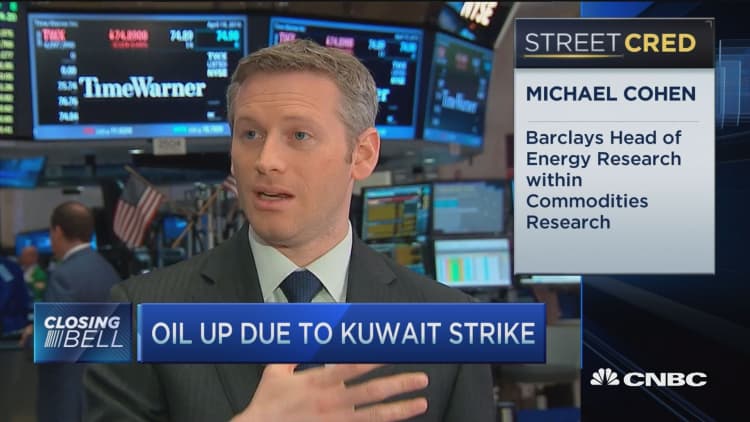
Doomsayers' forecast predicted oil prices sagging amid no deal in Doha, but the market has traded firmly, even as oil producers threaten to continue pumping crude into the glut.
Oil's current supply and demand balance is the market's catalyst, according to Barclays' head of energy commodities research. At the same time, while non-OPEC oil producers (especially in the U.S.) have begun to adjust to an oversupplied market, oil demand continues to give energy watchers mixed signals.
"We've seen production coming off 50,000; 100,000 barrels a day — every single month," Michael Cohen said in an interview with "Closing Bell." "We've seen really strong consumer-led demand for airlines and also for gasoline," he said on Tuesday.
Still, "industrial demand is coming off pretty steeply because of this reduction in drilling activity, reduction in rail activity," he added.
In this same vein, a strike in Kuwait, which has slashed the country's oil production by more than half, has driven the price of oil higher. U.S. crude settled up more than 3 percent at $41.08 a barrel on Tuesday. Similarly, the internationally traded Brent traded up nearly three percent to settle at $44.04 on the day.
Cohen expects unplanned outages to continue to affect the oil market, a constructive aspect from a balance perspective, but the strike in Kuwait won't last too long, he told CNBC.
The International Energy Agency's April report stated that both demand and supply in the oil sector have declined. The report said that global oil demand will ease to around 1.2 million barrels per day in 2016, below the 1.8 mb/d expansion of 2015. Similarly, the IEA found that global oil supply sank by 0.3 million barrels per day last month to 96.1 mb/d, "with annual gains shrinking to 0.2 mb/d, from 1.7 mb/d a month earlier."
Barclays is concerned about oil demand cooling this quarter, a factor that will keep oil trading between $35 and $45 a barrel, Cohen said. The firm considers that demand will rise again during the fourth quarter and oil prices could surge to $50 a barrel by the end of the year.
The volatility, however, will encourage bankruptcies in the oil and gas sector, Cohen said during his interview Tuesday. "We will see [bankruptcies] again and even more by the end of the year," he said.
— Reuters contributed to this report.


